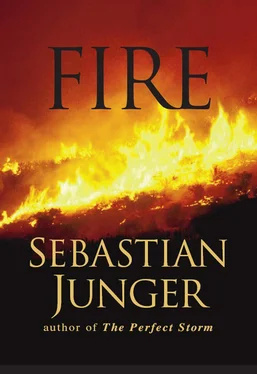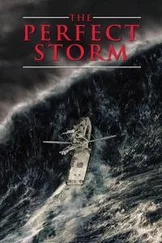That shifting of resources, Franz explained, is what BIFC is designed for. Everything from government-issue paper sleeping bags to food to foam fire retardant to Ken Franz himself is shipped around the country, following fires, following thunderstorms, even following droughts. There are 410 smoke jumpers and perhaps 20,000 active and on-call fire fighters in the United States. Should a smoke jumper’s father die, say, or his house burn down, BIFC would know what state, what fire, what division, and what 20-person crew he was on. Should an air tanker go down en route from Denver to Missoula—one of hundreds of flights during a busy day fighting fires out west—BIFC would know what route it was taking and when it was supposed to arrive. The immense task of keeping track of all these things is accomplished at the logistics center on the top floor of the main BIFC building, across the parking lot. Across one wall of the room is a huge map of the country. Cardboard cutouts representing airplanes are moved around on it; cards representing fire crews are switched from “available” to “unavailable” slots. More detailed information is stored on a computer. In late August 1987 lightning started two thousand fires across the West that burned almost a million acres. In ten days 22,500 fire fighters and forty-five tons of supplies were deployed to fight the fires. BIFC accounted for every chain saw, every hard hat, every gallon of retardant.
“Smoke jumpers are considered an initial attack force,” Franz went on. “That’s a generic term for the first response to a fire. The classic situation would be a lightning-struck tree in a remote area where two guys jump in, fell it, buck it up—put out what amounts to a small campfire. Basically, the whole world’s a jump spot; within a mile of any fire you can usually find a very acceptable place to land in. On a big fire you have to start somewhere, so you jump a whole planeload and establish an anchor point, at the tail of the fire. You clear helispots for landing supplies, and you work your way around the sides of the fire.”
Smoke jumpers land with eighty pounds’ worth of gear, including two parachutes, puncture-proof Kevlar suits, freeze-dried food, fire shelters, and a few personal effects. Following them in cardboard boxes heaved out of the airplane with cargo chutes are chain saws, shovels, ax-hoe hybrids called Pulaskis, sleeping bags, plastic cubitainers of water, and dozens of other things needed on a fire. If there’s an injured jumper, a medical emergency pack comes out of the plane. If it’s a fast-moving fire, the crew can call for boxes of explosives that can blast an instant fire line in the forest duff. The list of what can be thrown at a fire is endless—and expensive. A more cynical view, popular among many, is that the government puts fires out by throwing money on them until it starts to rain.
Not much of the money, however, goes to the fire crews. A jumper makes about $8.50 an hour. If the fire is uncontrolled, as, since smoke jumpers are initial attack, it almost always is, the crews get another 25 percent hazard pay. If they work overtime—again, almost a sure bet—they get time and a half. The jump itself has been ruled as simply another way of getting to the fire, like a bus or a pickup truck, so jumpers get straight pay when they leave the airplane and time and a quarter when they hit the ground. If they are injured on the jump, however, and don’t make it to the fire, the hazard pay does not kick in. From fifteen hundred feet it takes about a minute and a half to reach the ground with a parachute. At $8.50 an hour, that’s about 21 cents.
“In a good year you can make almost thirty thousand dollars,” said Franz. (As with all fire fighters, a “good” year is a year with a lot of fires; a “good” fire is a fire that isn’t brought under control too quickly.) “Under twenty thousand is more typical. That’s for six months. The rest of the year we sew.”
They sew everything: harnesses, fire line packs, jump bags, even little duffels with the BIFC flame logo on the side. They do it to save the government money, they do it because they’re better sewers than most manufacturers, and they do it to keep themselves employed. The only thing they don’t sew are the parachutes. Some jumpers are certified to make repairs, but the chutes themselves are bought from a manufacturer. The parachutes the BLM uses cost a thousand dollars apiece and are expected, with upkeep, to last at least ten years. They were of a design invented by a French kite maker in the early 1900s. They are called Quantum Q5 Ram Air parachutes.
“Ram air means there are cells that fill with air,” said Franz. “They make the canopy so rigid you could walk across it. You could also put a line on it and fly it like a kite; in Alaska, jumpers fly their chutes like kites. You steer with toggles and have a forward speed of twenty miles an hour. It’s a very high tech delivery system for a very low tech job; once we hit the ground we’re just fire fighters. Afterward we have to pack ten miles or more, to the nearest helispot. Our gear weighs over one hundred pounds, and usually we’re not even on trails; it’s harder work than fighting fires. It keeps you honest.”
Honest means capable of enduring a training regimen that used to weed out 30 percent of the preselected men at the training camp (overwhelmingly men, but not entirely). Rookies are considered the fittest and most perfectly trained because they have endured boot camp most recently: three hours of workouts a day, a jump simulator called the Mutilator, an array of courses and tests that virtually guarantee you’ll pull your ripcord after jumping out of the plane. Overwhelmingly, it works, though not always. In 1991 a jumper in Montana was killed because he didn’t reach for his ripcord until “ground rush,” when it was too late. The entire thing was caught on video because it was a training jump. The consensus was he froze.
“The biggest hazard is probably the fire itself,” Franz told me. “Felling burning snags, logs rolling down hillsides. Jumping is usually a relief. It’s hot in the airplane, and sometimes you feel sick; then suddenly you’re totally focused on what you’re doing. It’s a little dreamlike.”
After our talk Franz took me for a quick tour of the jump loft. He showed me the rigging room where the chutes are packed, and the sewing room, and the weight room. Afterward we returned to the conference table, and he popped a short tape into the VCR. It was quick and unprofessional but highly dramatic. It showed a jump crew working a fire at night, right on the line. At one point a sawyer was cutting down a huge ponderosa, and his saw was halfway through the trunk when flames started pouring out like liquid. The tree was hollowed out by fire, it turned out, and was drawing like a chimney. The sawyer kept cutting; the flames kept spurting; eventually the tree fell.
As I left, I asked Franz—against all hope—if there were any fires around for me to see. He told me I’d just missed a good one. An older couple from Pennsylvania had been towing a car behind their RV, and the car got a flat tire; sparks started a fire front two miles wide. Six thousand acres, a million dollars to put out.
“I suspect the government will try to collect too,” he said. “Try the dispatch office; they’ll know what’s going on.”
The dispatch office for the Boise National Forest was a trailer east of the airfield. “I just came from BIFC,” I told the young woman behind the desk. “I’m a reporter. Are there any fires?”
I felt a little bad asking the question. She didn’t blink. “Seven hundred acres as of midnight last night,” she said, spreading a map of Idaho out on the table. “Lightning-started, wind-driven, with three helicopters and twenty-two crews. It’s called the Flicker Creek fire. They’ve called in a type one overhead team.”
Читать дальше












